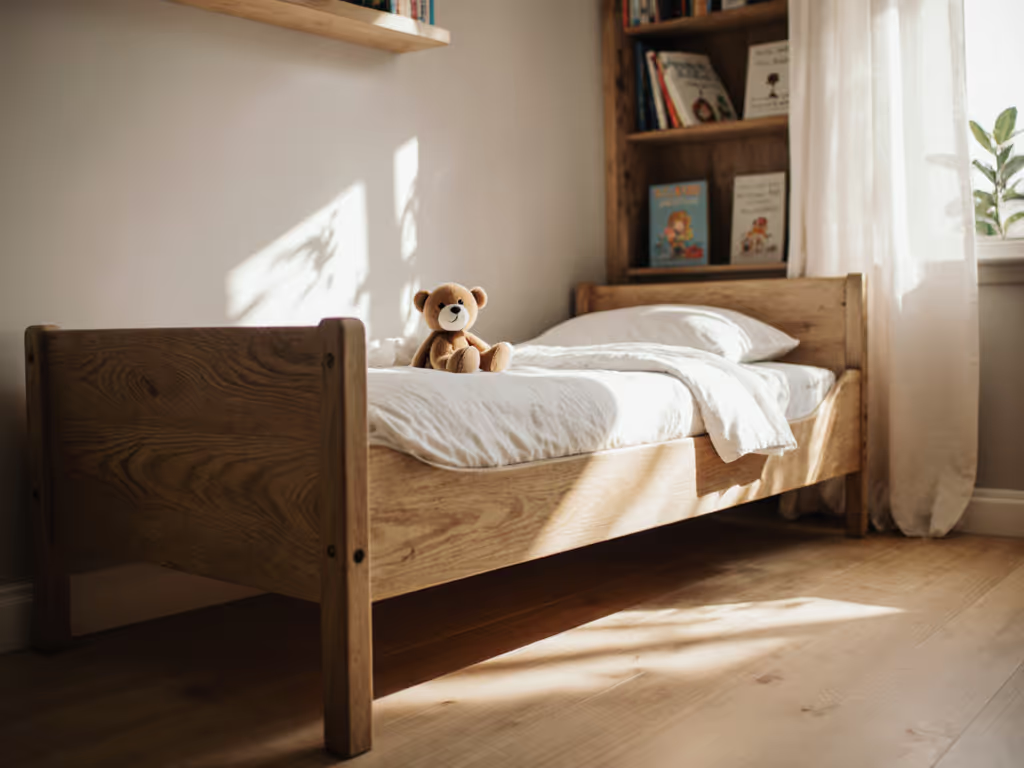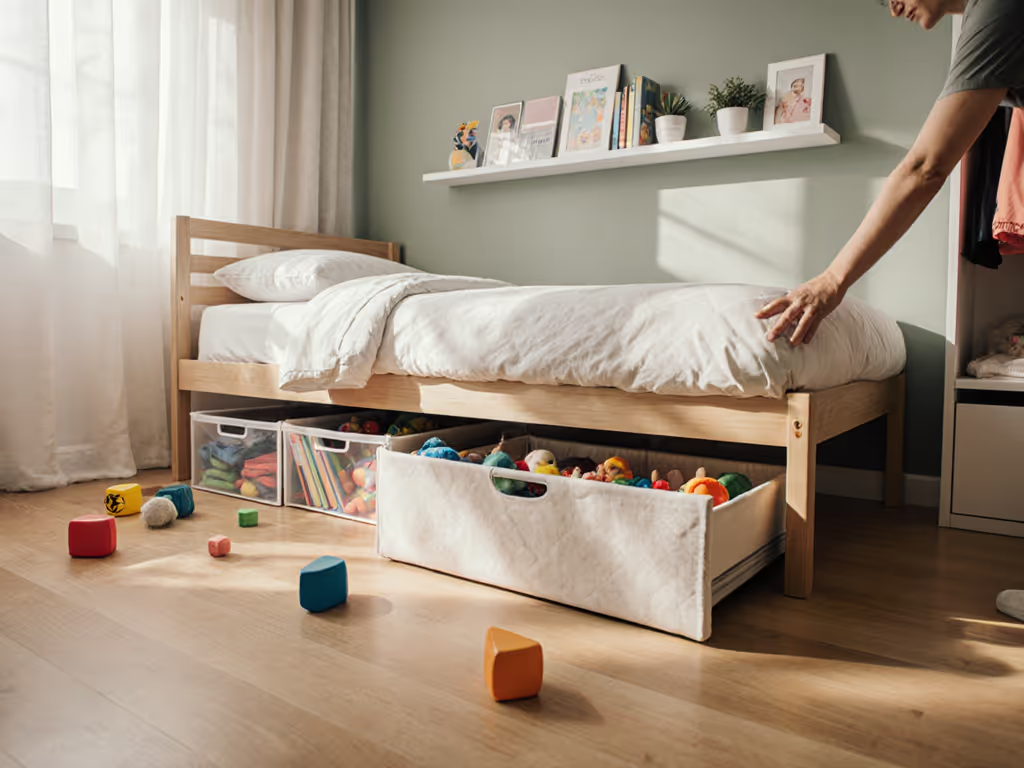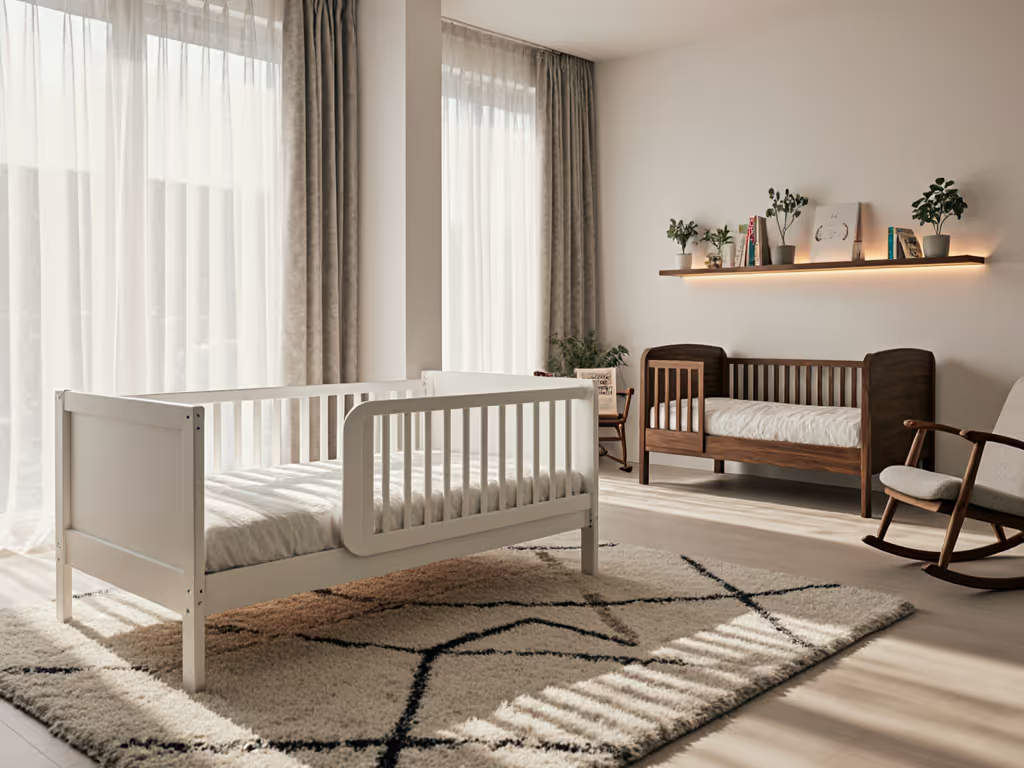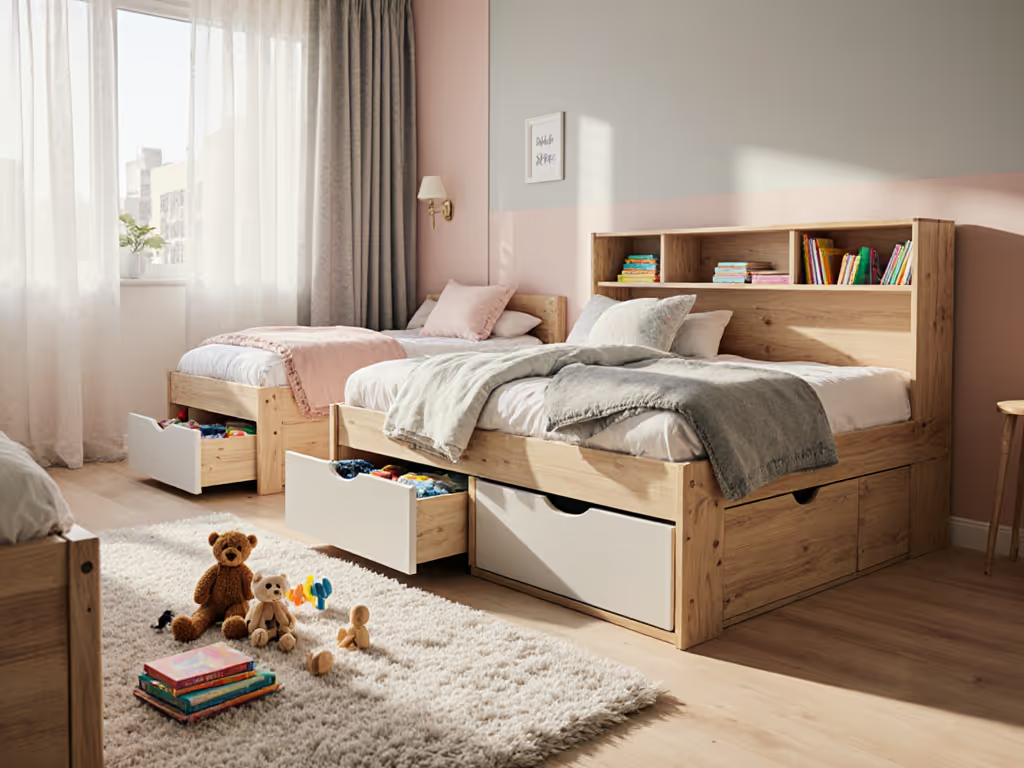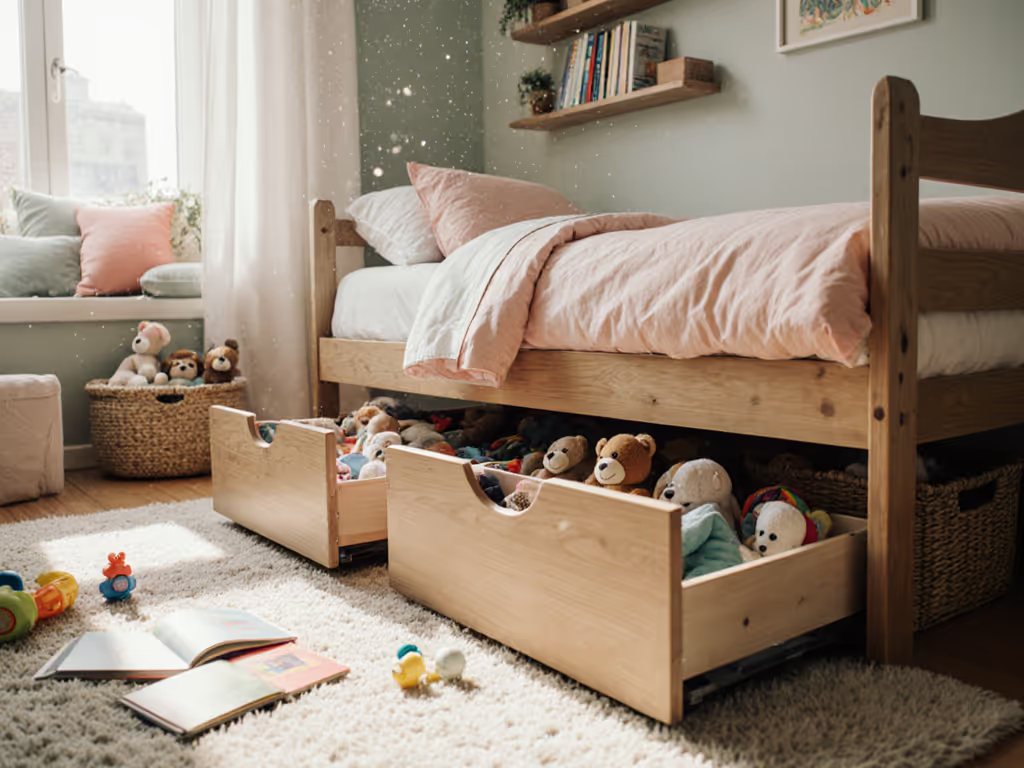
7 Essential Materials for Toddler Beds Every Parent Should Know
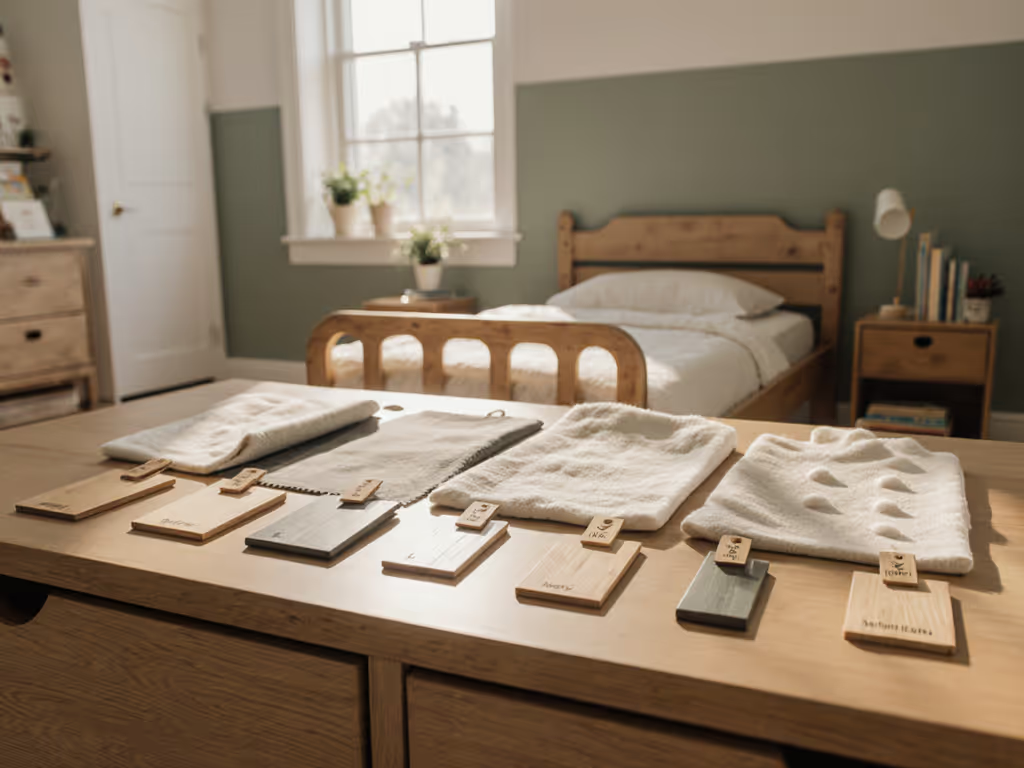
Did you know that over 70 percent of parents cite safety as their top concern when choosing toddler beds? The right bed material plays a huge role in your child’s comfort, health, and peace of mind every night. From solid wood’s sturdy protection to the eco-friendliness of bamboo and the easy care of plastic designs, understanding your options ensures your toddler gets a secure and nurturing place to sleep.
Quick Summary
| Takeaway | Explanation |
|---|---|
| 1. Choose solid wood for safety and durability | Solid wood beds offer stability and can endure active toddlers, avoiding potential breakage common with cheaper materials. |
| 2. Consider non-toxic finishes for health | Non-toxic finishes help reduce harmful chemical exposure in your child's sleeping environment, ensuring safety during sleep. |
| 3. Look for certified low-emission engineered wood | Selecting engineered wood with low emissions can provide budget-friendly options while maintaining health safety for your child. |
| 4. Bamboo beds are eco-friendly and hypoallergenic | Bamboo offers a sustainable choice that resists allergens and contributes to environmental health alongside your child’s sleep quality. |
| 5. Metal frames maximize space and longevity | Metal beds are durable yet lightweight, making them great for compact spaces and adaptable as your child's needs change. |
1. Solid Wood: Durable and Safe Choice for Toddlers
Parents hunting for a toddler bed that will keep their little one safe and comfortable need look no further than solid wood beds. Unlike cheaper alternatives that might wobble or break, solid hardwood beds provide unparalleled durability and stability for active young sleepers.
Not all woods are created equal when it comes to toddler furniture. Hardwoods like oak, maple, beechwood, hickory, and cherry stand out as premium materials that offer exceptional strength and safety. These woods naturally resist wear and tear while providing a stable sleeping environment that can withstand the energetic movements of curious toddlers.
What makes solid wood truly remarkable is its structural integrity. Beds constructed with reinforced joints using screws or bolts create a much more stable framework compared to furniture relying on simple glue or nail connections. This means your toddler's bed will remain sturdy through countless jumping sessions, pillow fights, and imaginative play scenarios.
Beyond durability, solid hardwoods offer another critical advantage: non toxicity. Unlike manufactured materials that might release harmful chemicals, natural woods like oak and maple are inherently safe. They do not off-gas dangerous substances that could potentially impact your child's respiratory health or overall well being.
When selecting a solid wood toddler bed, look for these key characteristics:
- Reinforced corner joints
- High quality wood species (oak, maple, beechwood)
- Smooth, splinter-free surfaces
- Solid construction without reliance on weak adhesives
By investing in a solid wood bed, you are not just purchasing furniture. You are creating a safe, reliable sleep sanctuary that can potentially grow with your child through multiple developmental stages.
2. Engineered Wood: Budget-Friendly And Versatile Option
For parents watching their budget while seeking functional toddler bed solutions, engineered wood presents an intriguing alternative to solid hardwood furniture. These manufactured wood products like plywood and medium density fiberboard offer affordability and design flexibility that can be appealing to families navigating tight financial constraints.
Engineered wood represents a composite material created by binding wood strands, particles, or fibers together with adhesive under heat and pressure. While this manufacturing process enables lower cost production, it also introduces potential concerns parents should carefully consider. Not all engineered woods are created equal in terms of safety and quality.
Plywood and medium density fiberboard (MDF) can provide attractive design options and lighter weight compared to solid wood. However, the adhesive binding these materials might emit volatile organic compounds (VOCs) like formaldehyde. These chemical emissions raise potential health concerns, especially in enclosed bedroom environments where young children spend significant sleeping time.
When considering engineered wood for a toddler bed, parents should prioritize low emission options. Look for manufacturers who:
- Use formaldehyde free adhesives
- Provide third party certifications for material safety
- Offer transparent manufacturing process details
- Include ventilation recommendations
While engineered wood beds might seem budget friendly initially, the potential long term health implications mean careful selection is crucial. Some manufacturers now produce engineered wood products with significantly reduced chemical emissions, making them a more viable option for health conscious parents seeking affordable furniture solutions.
Ultimately, the decision between solid and engineered wood involves balancing cost, design preferences, and potential health considerations. Researching specific product details and manufacturer certifications can help you make an informed choice that protects both your budget and your child's wellbeing.
3. Bamboo: Eco-Friendly Material for Healthier Sleep
Parents seeking a sustainable and health conscious material for their toddler's bed have an extraordinary option in bamboo. This remarkable plant offers a unique combination of environmental friendliness and practical benefits that make it stand out among furniture materials.
Bamboo is not just another trendy green material. It represents a powerful solution for environmentally aware families who want to create healthy sleeping environments for their children. Incredibly fast growing and requiring minimal resources, bamboo can be harvested without causing significant ecological damage. Unlike traditional hardwood forests, bamboo regenerates rapidly and can be cultivated without irrigation, pesticides, or fertilizers.
One of bamboo's most compelling attributes is its natural hypoallergenic properties. This means the material inherently resists dust mites, bacteria, and other potential allergens that might disrupt your toddler's sleep. For parents concerned about respiratory health and potential allergic reactions, bamboo provides a naturally protective sleeping surface.
The environmental credentials of bamboo are equally impressive. This plant can sequester significantly more carbon compared to traditional hardwood forests, making it a low carbon material choice. When you select a bamboo toddler bed, you are not just investing in your child's comfort but also contributing to broader environmental sustainability efforts.
When considering a bamboo toddler bed, look for these key characteristics:
- Third party sustainability certifications
- Transparent manufacturing processes
- Solid construction techniques
- Minimal chemical treatments
By choosing bamboo, you are making a statement about your commitment to both your child's immediate health and the planets long term wellbeing. This material represents more than just a furniture choice it is a thoughtful approach to parenting that considers both immediate comfort and future environmental impact.
4. Metal Frames: Space-Saving and Long-Lasting Design
For parents navigating tight living spaces or seeking furniture that grows with their child, metal frame toddler beds offer an innovative and practical solution. These sleek sleeping platforms combine durability with intelligent design that maximizes bedroom functionality.
Metal frames represent a modern approach to children's furniture. Unlike traditional wooden beds, these structures provide exceptional structural integrity while maintaining a lightweight profile. Powder coated finishes elevate metal beds beyond simple metal constructions by adding layers of protection against rust, scratches, and everyday wear.
The true magic of metal frame toddler beds lies in their incredible versatility. These beds are typically designed with adjustable features that allow them to adapt as your child grows. Many models can be easily reconfigured or expanded, transforming from a compact toddler bed to a more substantial youth bed without requiring a complete replacement.
Space conscious parents will appreciate how metal frames create visual lightness in a room. Their slender profiles and clean lines make bedrooms feel more open and less cluttered compared to bulky wooden alternatives. This design approach is particularly beneficial in smaller apartments or shared bedroom environments where every square foot matters.
When selecting a metal frame toddler bed, consider these essential qualities:
- Smooth rounded edges for child safety
- Robust powder coated finish
- Adjustable or modular design
- Lightweight yet sturdy construction
- Easy assembly and maintenance
Beyond aesthetics, metal frame beds offer remarkable longevity. Their resistance to moisture, potential for refinishing, and ability to withstand active toddler play make them a smart investment for budget minded families seeking reliable furniture that transcends short term needs.
5. Plastic: Lightweight for Easy Room Arrangement
In the world of toddler furniture, plastic beds emerge as a surprisingly practical option for parents seeking flexible and easily manageable bedroom solutions. These lightweight sleeping platforms offer unique advantages that can transform how you approach your child's sleeping space.
Plastic toddler beds represent an innovative approach to children's furniture design. Their primary strength lies in remarkable maneuverability. Unlike heavy wooden or metal frames, plastic beds can be effortlessly repositioned, allowing parents to quickly redesign room layouts or accommodate changing spatial needs without straining muscles or risking furniture damage.
Modern plastic beds have evolved far beyond basic designs. Today's options feature sophisticated molding techniques that create sturdy, ergonomic sleeping surfaces capable of withstanding active toddler energy. Manufacturers now prioritize safety by using high quality, non toxic plastic materials that meet rigorous child safety standards.
The lightweight nature of plastic beds makes them ideal for families who frequently rearrange living spaces or move residences. Parents with multiple children or those living in apartments will appreciate how simple these beds are to transport, clean, and reconfigure. A plastic bed can seamlessly transition between rooms or even accompany your child during travel or temporary relocations.
When selecting a plastic toddler bed, consider these critical factors:
- Rounded safety edges
- Smooth surface for easy cleaning
- Robust construction
- Non toxic material certifications
- Weight capacity appropriate for toddlers
While plastic beds might not offer the same timeless aesthetic as wooden alternatives, they provide unparalleled practicality. Their combination of lightweight design, affordability, and adaptability makes them an excellent choice for parents prioritizing functional living solutions.
6. Upholstered Beds: Added Comfort and Cozy Appeal
For parents wanting to transform their toddler's bedroom into a soft and inviting sanctuary, upholstered beds offer a perfect blend of comfort and style. These plush sleeping platforms go beyond traditional furniture by creating a warm, nurturing environment that can help children feel secure and relaxed.
Upholstered toddler beds distinguish themselves through luxurious fabric coverings that add an extra layer of sensory comfort. Unlike hard surface beds, these designs incorporate padded headboards and soft edges that create a gentle sleeping environment. The textile components can help dampen noise, provide additional cushioning, and create a more inviting sleep space that feels like a personal cocoon.
Design versatility stands as another significant advantage of upholstered beds. Modern manufacturers offer an incredible range of fabric colors, textures, and patterns that can seamlessly integrate with various bedroom decor styles. Whether your aesthetic leans toward minimalist neutrals or playful bright tones, an upholstered bed can become a statement piece that grows with your child's changing preferences.
Parents should approach upholstered bed selection with strategic considerations. Fabric quality and maintenance become critical factors in ensuring long term functionality. Opt for beds featuring removable, washable covers that can withstand inevitable spills, accidents, and general toddler wear and tear.
When selecting an upholstered toddler bed, prioritize these key characteristics:
- Stain resistant fabric treatments
- Removable and machine washable covers
- Robust internal padding
- Smooth rounded edges
- Allergen resistant materials
Beyond physical comfort, upholstered beds can provide psychological benefits. The soft surrounding environment can help children feel more secure, potentially supporting better sleep patterns and creating a personal space that feels uniquely theirs. By selecting a thoughtfully designed upholstered bed, you are investing in more than just furniture you are crafting a nurturing sleep environment.
7. Certified Non-Toxic Finishes: Ensuring Safety First
Every parent wants a sleeping environment that protects their toddler from harmful chemicals. Non toxic bed finishes represent a critical yet often overlooked aspect of creating a safe and healthy bedroom space for your little one.
The world of furniture finishes can be surprisingly complex and potentially dangerous. Many traditional wood treatments contain volatile organic compounds (VOCs) that can off-gas harmful chemicals into your child's immediate breathing environment. These substances may include formaldehyde, phthalates, and heavy metals that could potentially impact your toddler's respiratory health and long term well being.
Certified non toxic finishes offer a comprehensive solution to these hidden health risks. Parents should look for treatments derived from natural sources such as food grade linseed oil, beeswax, and plant based oils. These alternatives provide protection and aesthetic appeal without introducing potentially harmful synthetic chemicals. Water based paints and stains with zero VOC certifications represent another excellent option for creating a safe sleeping surface.
Understanding certification labels becomes crucial in making informed decisions. Look for third party verifications that specifically test for chemical emissions and confirm the absence of dangerous substances. These certifications go beyond marketing claims and provide scientific validation of a finish's safety profile.
When evaluating bed finishes, prioritize these key characteristics:
- Zero VOC certifications
- Natural plant based ingredients
- Third party safety testing documentation
- Transparent manufacturing processes
- Absence of formaldehyde and heavy metals
By selecting certified non toxic finishes, you are doing more than purchasing furniture. You are making a proactive health choice that creates a pure, safe sleeping environment for your most precious family member. Every layer of protection matters when it comes to your toddler's immediate and long term well being.
This table summarizes the main materials used for toddler beds, highlighting their features, benefits, and key considerations as discussed in the article.
| Material | Features | Benefits | Key Considerations |
|---|---|---|---|
| Solid Wood | Reinforced joints, non-toxic, smooth surfaces. | Durability, safety, structural integrity. | Invest in high-quality species like oak or maple. |
| Engineered Wood | Cost-effective, design flexibility. | Budget-friendly, versatile design. | Ensure low emissions and check for non-toxic adhesives. |
| Bamboo | Sustainable, hypoallergenic. | Eco-friendly, resists allergens. | Look for third-party sustainability certifications. |
| Metal Frames | Lightweight, powder-coated finish, adjustable design. | Longevity, adaptability for growth. | Prioritize smooth rounded edges for safety. |
| Plastic | Lightweight, maneuverable. | Easy to rearrange, non-toxic. | Confirm robust construction and weight capacity. |
| Upholstered Beds | Luxurious fabric, noise-dampening. | Added comfort, cozy appeal. | Opt for stain-resistant, removable covers. |
| Non-Toxic Finishes | Made with natural ingredients like linseed oil, beeswax. | Ensures a safe and healthy sleeping environment. | Seek zero VOC certification and third-party testing. |
Take the Next Step Toward a Safer Toddler Bedroom
After discovering the must-know materials for toddler beds, you may still feel unsure about making the right choice for your child’s health, safety, and comfort. As a parent, you want to avoid hidden toxins, flimsy construction, and wasted space. You deserve simplified guidance tailored to first-time buyers who have concerns about durability, non-toxic finishes, and eco-friendly options.
If you are searching for answers on solid wood versus engineered wood or worried about safe finishes for your toddler's new bed, City Toddler Beds has you covered. Our detailed guides and resources break down everything from space-saving bed ideas to non-toxic material certifications, all designed to help you make confident, informed decisions. Identify the best sleep solution for your unique family situation now. Start your toddler bed journey with trustworthy advice and practical tips that put your child’s well-being first.
Frequently Asked Questions
What are the benefits of solid wood toddler beds?
Solid wood toddler beds offer durability and stability, ensuring a safe sleeping environment for active children. Look for beds made from hardwoods like oak or maple that feature reinforced joints to enhance their structural integrity.
How can I determine if engineered wood toddler beds are safe?
To ensure the safety of engineered wood toddler beds, look for products that use formaldehyde-free adhesives and come with third-party safety certifications. Prioritize options that minimize VOC emissions to protect your child's health.
Why should I consider bamboo for a toddler bed?
Bamboo is an eco-friendly material that grows rapidly and is naturally hypoallergenic, making it suitable for young children. Research brands that offer bamboo beds with third-party sustainability certifications to ensure they meet your health and environmental standards.
What features should I look for in a metal frame toddler bed?
When selecting a metal frame toddler bed, ensure it has smooth rounded edges, a sturdy powder-coated finish, and an adjustable design. These features not only enhance safety but also allow the bed to grow with your child, providing long-lasting value.
Are plastic toddler beds a good option for frequent movers?
Yes, plastic toddler beds are lightweight and easy to rearrange, making them ideal for families who move often or need flexible room arrangements. Ensure to select models made from non-toxic materials that meet safety standards for additional peace of mind.
What should I know about upholstered toddler beds?
Upholstered toddler beds provide added comfort with their soft fabric coverings and padded headboards, which create a cozy sleeping environment. Choose beds with stain-resistant fabrics and removable covers to maintain cleanliness and durability over time.

